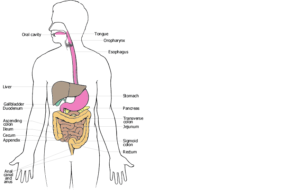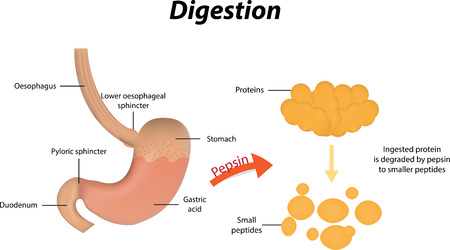The digestive system consists of organs that break down food into components that the body uses for energy and for building and repairing cells and tissues.
Food passes down the throat, through a muscular tube called the esophagus, and into the stomach, where it continues to be broken down. From the stomach, the partially digested food passes into a short tube called the duodenum (first part of the small intestine). The jejunum and ileum are also part of the small intestine. The liver, the gallbladder, and the pancreas produce enzymes and substances that help with digestion in the small intestine.
The last section of the digestive tract is the large intestine that includes the cecum, colon, and rectum. The appendix is a branch off the large intestine; it has no known function. Indigestible remains of food are expelled through the anus. These are the basics of the digestive system. A more detailed explanation is below.
The small intestine is about1 1/2 inches to 2 inches around, and is located beneath the stomach. Its also about 22 feet long and has the important task of breaking down the food mixture so your body can absorb all the nutrients it needs from food you eat. So, while that tuna is full of protein, the small intestine is what is responsible for unleashing its power for you.
But the small intestine can’t break down food for its nutrients by itself – it gets help from three other parts of the digestive system. These parts are the pancreas, the liver, and the gallbladder. They are not part of the digestive tract itself, but they help to make up the whole digestive system. How? By secreting different enzymes to the first part of the small intestine. These enzymes help to digest food and allow the body to absorb its nutrients. The pancreas makes juices that help the body digest fats and protein. Bile from the liver helps to absorb fats into the bloodstream. And the gallbladder is like a warehouse for this bile, holding onto extra amounts of it for when the body needs it.
In the upper part of the small intestine, a partially digested mixture of food combines with excretions from the pancreas and the liver. This mixture next moves into the lower part of the small intestine, getting broken down even further. When the mix is almost at the end of its journey through the small intestine, usually requiring up to 4 hours, the nutrients from the food finally pass through the wall of the small intestine and into the blood. Once the nutrients have entered your blood, the blood takes them to a major checkpoint: the liver.
Love Your Liver
The liver is one of your body’s larger organs, sitting on the right side of your body near the digestive tract. In addition to making bile to help with digestion, the liver is the first place that the nutrients from food go. The blood brings them directly to the liver, which processes the nutrients by filtering out any harmful substances or wastes. It turns some of the waste into more bile, which goes to the small intestine to help with digestion or to the gallbladder for storage.
In lay terms, the liver helps figure out how many nutrients will go to the rest of the body, and how many will stay behind in storage! For example, the liver stores certain vitamins and a type of sugar that your body uses for energy.
Once nutrients have passed through the liver they are transported through the blood stream to the rest of the body.
The Large Intestine The large intestine is fatter than the small intestine (3 inches to 4 inches around), and it’s almost the last stop on the digestive tract. Like the small intestine, it is packed into the body, and if it were stretched out would be about 5 feet long. The large intestine has a tiny tube with a closed end coming off it called the appendix. Although the appendix is part of the digestive tract, it doesn’t perform any known functions, although scientists think that the appendix may have been a useful part of the digestive tract millions of years ago.
After almost all of the nutrients have been absorbed from the liquid food mix in the small intestine, there will still be some parts of ingested food that your body can’t use. This leftover waste moves into the large intestine to begin its long journey out of your body. On its way, it goes into the colon, the part of the large intestine where most of the fluid and some minerals that are left in the liquid mix are absorbed into the blood. As the fluid leaves the mix, the waste that’s left gets harder and harder as it keeps moving along, until it becomes a solid.
When this solid waste reaches the end of the large intestine, it may have been in your system for several days. The amount of time that the waste spends in the large intestine depends on the kind of food that was eaten and how a person’s body works. The large intestine pushes the waste into the rectum, the last stop on the digestive tract. From here it is excreted from the body.
Once you understand this basic process, it will shed light on nutrition and why its important to consume a variety of foodstuffs. For example fiber in the form of fruits and vegetables, which has been shown to reduce the risk of colon cancer. These foods help those solids bulk up in the large intestine so you can move them on out. When you take care of your digestive system, it will do you right!







